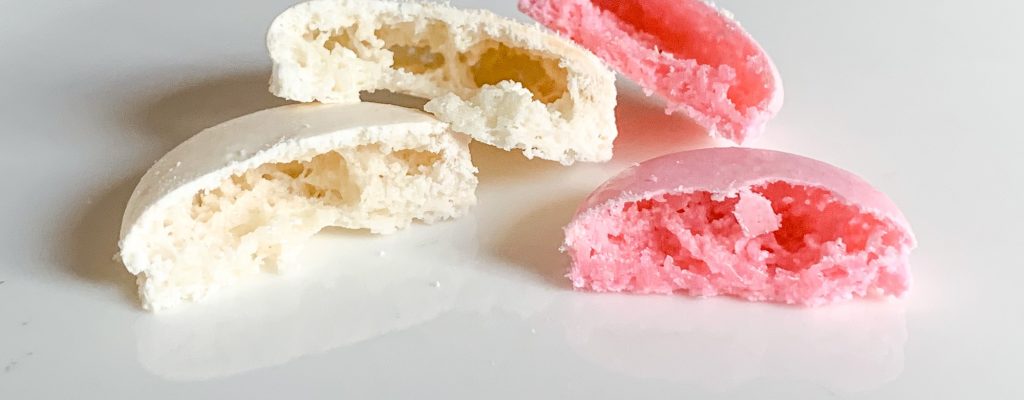The Ultimate Macaron Troubleshooting Guide
Baking the perfect macarons might seem like an easy thing to do at first, but as you probably already have found out, it is not that straightforward at all. There are so many ways one can mess up the baking process as macarons are one of the most complicated pastries to make.
As I have a long history of baking macarons, I have struggled through all the problems by myself and found fixes to most of the common issues. It has taken me a lot of time to gather this information and I’m super glad to share it with the world.
I have written down and explained the causes of the problems and also how to resolve them. Hopefully, you can find all the answers you ever need to troubleshoot macaron problems from this post and finally bake flawless macarons.

As an Amazon Associate, I may earn from qualifying purchases.
Macarons with spread feet
Macaron’s foot is a sign of a well-baked macaron. It looks like a little frill around the edge of the macaron shell. This beautiful little ruffle grows in the oven and makes the almond-meringue cookie a macaron. The perfect macaron feet are not too tall, are straight, and are steady.
In this picture above, are obviously not well-baked macaron shells.

Why did my macarons spread?
Spread macaron feet look like a little skirt on the macaron. It is a sign that something went wrong and you probably made some mistakes while making them. There can be several reasons why macarons have spread feet:

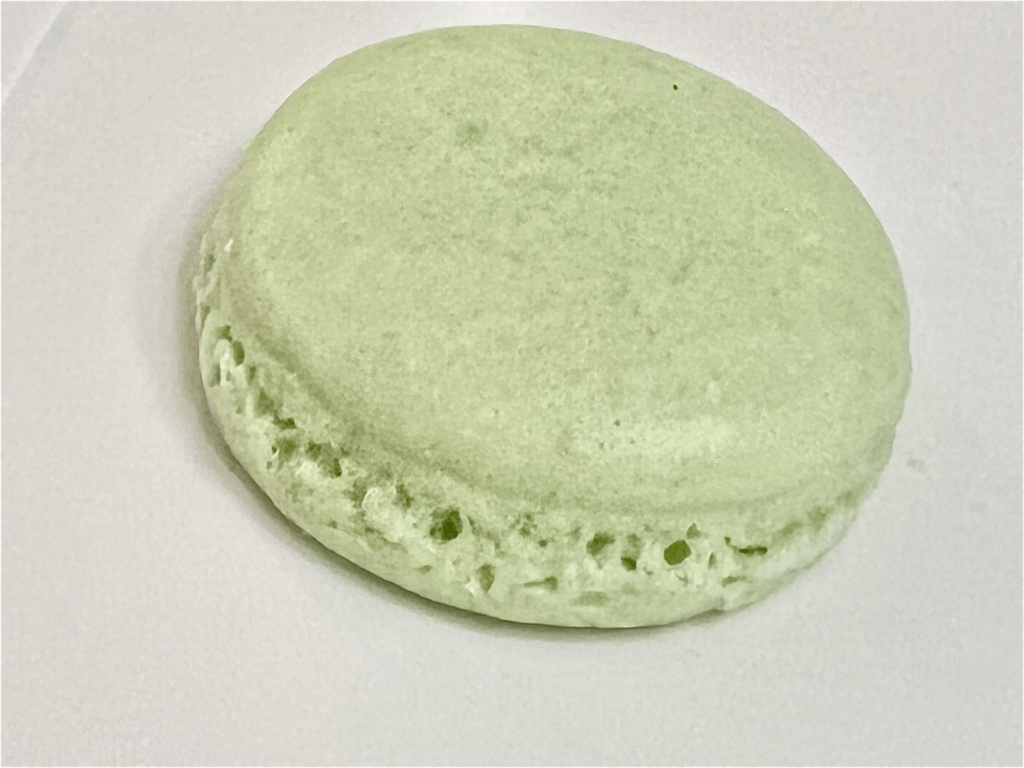
Over-mixed batter
Macarons with spread feet are flatter than normal macarons and this can be caused by an over-mixed batter. When the macaron batter is over-mixed, it gets runny and won’t rise in the oven as much as it should.
It can cause many problems such as hollows, cracks, and spread feet. It’s important to know when it is time to stop the folding process. Once it gets too runny, it is already too late – you can’t fix the over-mixed batter.
Under-mixed meringue
Meringue plays a very important role in how the macarons will turn out. If you mess up the meringue, your macarons will probably turn out messed up as well. Make sure your meringue has stiff peaks and looks smooth and shiny. If it looks too soft and runny, keep whipping it.
Too high oven temperature
Spreading can be caused by setting your oven temperature too high. Usually, it is a combination of overmixed batter and the wrong temperature that ruins your macarons. Try using a lower temperature and the most important thing again – do not overmix!
Wet batter
Too wet batter can cause problems such as macarons sticking to the pan, which might result in ruined macarons. There can be several reasons why the batter is too wet:
- Using the liquid food coloring
- Meringue is under-mixed
- Your tools are not cleaned well
- The climate is very humid
Using wrong or too much food coloring
Avoid using liquid food coloring as it can mess up the batter consistency. The best food colors for macarons are definitely gel colors. Nevertheless, don’t overuse them – too much gel coloring can also ruin the macarons.
Fortunately, you need just a tiny bit of high-quality gel coloring to get a nice and vibrant color on your macarons.
TIP: Read more on how to correctly color your macaron shells here: Colorful Macaron Shells With Gel Food Coloring.
Wrong measurements
It is very important to follow the recipe exactly and measure all the ingredients accurately. For this, you will need good quality and reliable tools such as a kitchen scale.
Unfortunately, you can’t make perfect macarons without great tools. Luckily for you, I have written a post about all the tools you need to succeed at making macarons.
Lopsided macaron shells
Lopsided macarons only look perfect from one side, but the other side usually has no feet at all or just a little bit of it. Lopsided macarons are a common sight for beginner bakers and they can be quite frustrating to encounter.
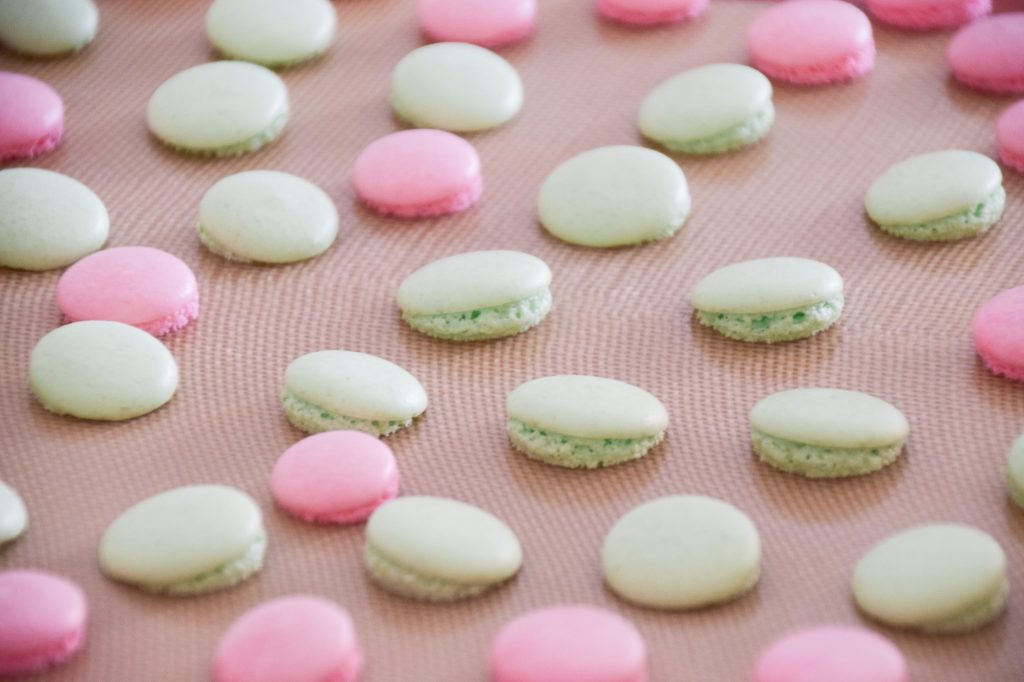
There can be many reasons for lopsided macarons:
Resting time too long
A lot of recipes guide you to rest your macarons. Many bakers are using the resting method, but on the other side, many are not. If you prefer to rest them, be very careful to not over-rest them.
I heard a story about a lady, who got tired while making macarons and she left a few batches to rest overnight just to continue the next day. Unfortunately, it does not work like that with macarons. You can rest them, but I do not recommend doing it for over an hour.
Over-resting can also happen when you only have one oven and you are making a lot of macarons at the same time. If that’s the case, some batches might have to wait too long and can turn out lopsided because they just dried for too long. It is better to make a smaller amount of batter at a time.
Uneven heat
The older the oven is, the bigger the chances are that this is the reason why your macarons are lopsided. It is very common that over time the oven starts heating unevenly. I am sure that many of us have noticed it at some point.
For example, if you take your dinner out of the oven and it is more crispy on one side. It indicates that the oven’s heat is uneven. Unless getting a new oven is not an option, make sure to rotate the trays as they bake to get more even heat on all sides.
Wrinkly parchment paper
Using parchment paper for macarons is tricky. Always be sure that you are using high-quality parchment paper that is thick and straight without any wrinkles. Using cheap, thin, and low-quality parchment paper for macarons can make them lopsided. Why?
The reason is that the macaron batter is wet and putting it on the parchment paper can turn it wrinkly. When the paper gets wrinkly, the batter might start spreading. The perfect shape of your macarons can be compromised when the paper wrinkles and is uneven. This ends up affecting the evenness of your macarons and can turn them lopsided.
TIP: You can always use a silicone mat instead of parchment paper to avoid wrinkling. I highly recommend taking a glance at my other post, where I compare silicone mats to parchment papers.
Wrong piping techniques
Make sure you always pipe the macaron batter at a 90-degree angle. Look how to correctly pipe the macarons batter. Piping the macarons more on one side and unevenly can cause the batter to spread and you can end up with lopsided macarons.
Too strong convection fan
Many bakers love to bake macarons on fan mode. I personally also love using it as the macarons are rising perfectly with that mode and have the perfect feet! Keep in mind that every oven and macaron recipe is different, so what works for one, might not work for you.
If the oven gets too hot in fan mode, it can make your macarons end up with lopsided shapes. It can blow a part of the batter to the other side. In this case, one side of the macaron has more batter than the other and you will end up with uneven macarons. To make it work, turn down the fan or lower the temperature.
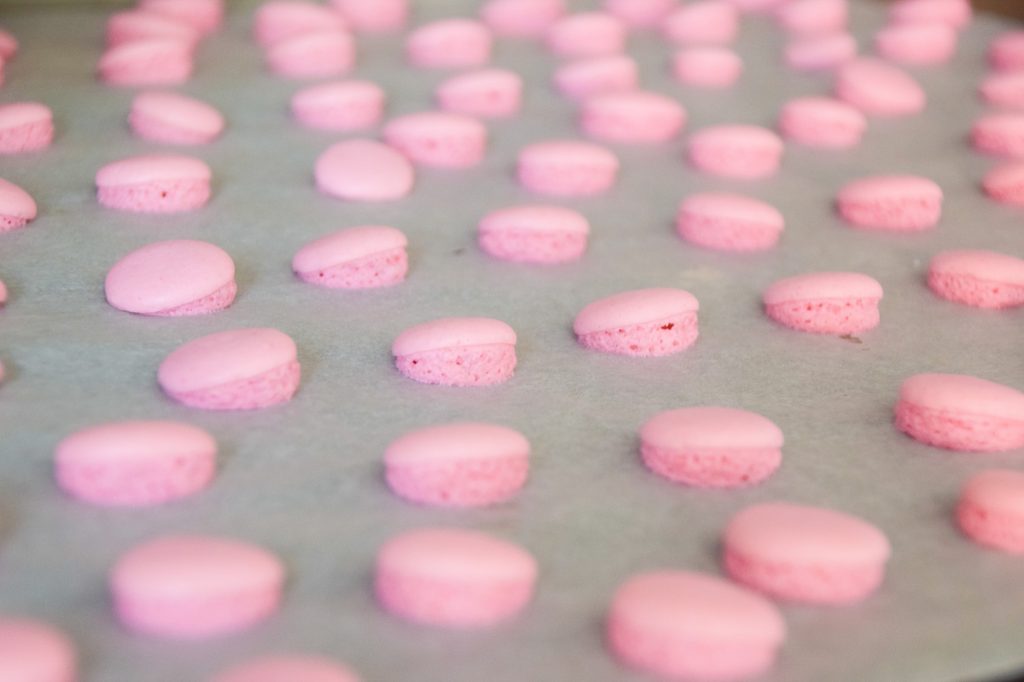
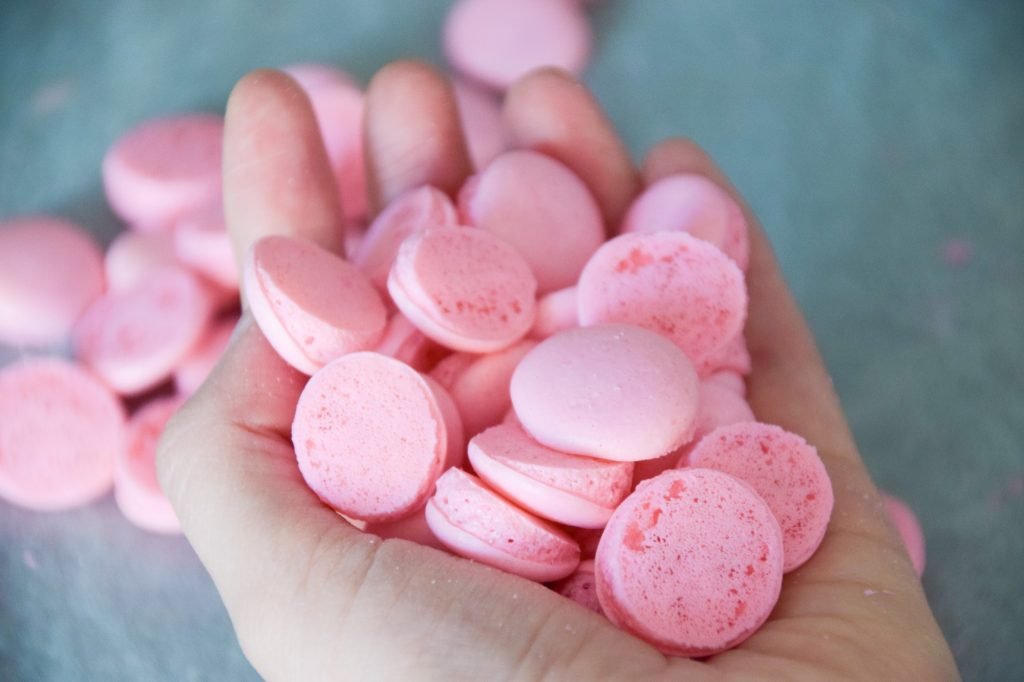
Wrinkled macaron shells
The texture of the macaron is a key component of its success. You want your macarons to have fluffy, smooth, and shiny shells.
Unfortunately, it is quite a common problem for even an advanced baker to see wrinkles on the macaron shells. To find the core of your problem, I have gathered together the most typical reasons for wrinkled macaron shells:
Oily almond flour
Macarons batter and any kind of oils do not belong together. You can see and feel if the almond flour is too oily. To test it, try rubbing the crushed almonds between your fingers for a few seconds. When your fingers get oily or when the flour feels “wet” while touching, it probably is too oily.
If that is the case, you can still save the oily flour. Turn the oven to 240°F (115°C). Just lay your almond flour over the parchment paper and let it dry in the oven for about 1 hour. Spread the flour with a spatula every 20 minutes. This should dry the flour enough and you can still use it for macarons.
Overcooked sugar syrup
To avoid overcooking sugar syrup, you definitely need a candy thermometer. There is no way to get the exact temperature you need without using one. Sugar syrup is needed if making macarons in the Italian method.
If you don’t have one at home and really want to make macarons, I recommend using the French Method – you do not need a candy thermometer using this method.
Low oven temperature
Using too low oven temperature can be one reason your macarons turn out wrinkled. Macarons can’t bake enough and the bottom won’t solidify well enough in the oven. Try using a higher temperature next time.
Over-mixed meringue
Over-mixing the meringue can make it fragile once baked. This can cause a lot of problems and wrinkled shells are one of them.
Over-mixed batter
Over-mixing the batter will turn it runny. A runny batter can make your macarons wrinkled and fragile. Folding the macaron batter is one of the most important steps in the macaron-making process and you need to take it seriously – do not hurry, be gentle, and do not over-mix!
Too much food coloring
As over-mixing makes the batter runny – so does adding too much food coloring. Avoid using liquid food coloring, use gel-based food coloring instead, and do not overshoot with it.
Keep these tips in mind and I am sure you will never see wrinkled macarons again in your kitchen!
Too soft and fragile speckled macaron shells
When your macarons turn out too soft and fragile, you most probably didn’t bake them long enough, or the temperature was too low. These are the main but not only reasons.
Usually, the fragile and too soft macarons look perfect in the oven. You will typically see the problem a little after you take them off from the oven. This can be very frustrating because they look good at first but suddenly they are completely ruined.
Shortly after taking them off from the oven, the soft and fragile macarons turn a little darker and you will see that something is very wrong. Even gently touching the shell will break it. You can wait until the macaron dries to see if that helps to get the shell stronger. If that does not help, there is sadly nothing else to do.

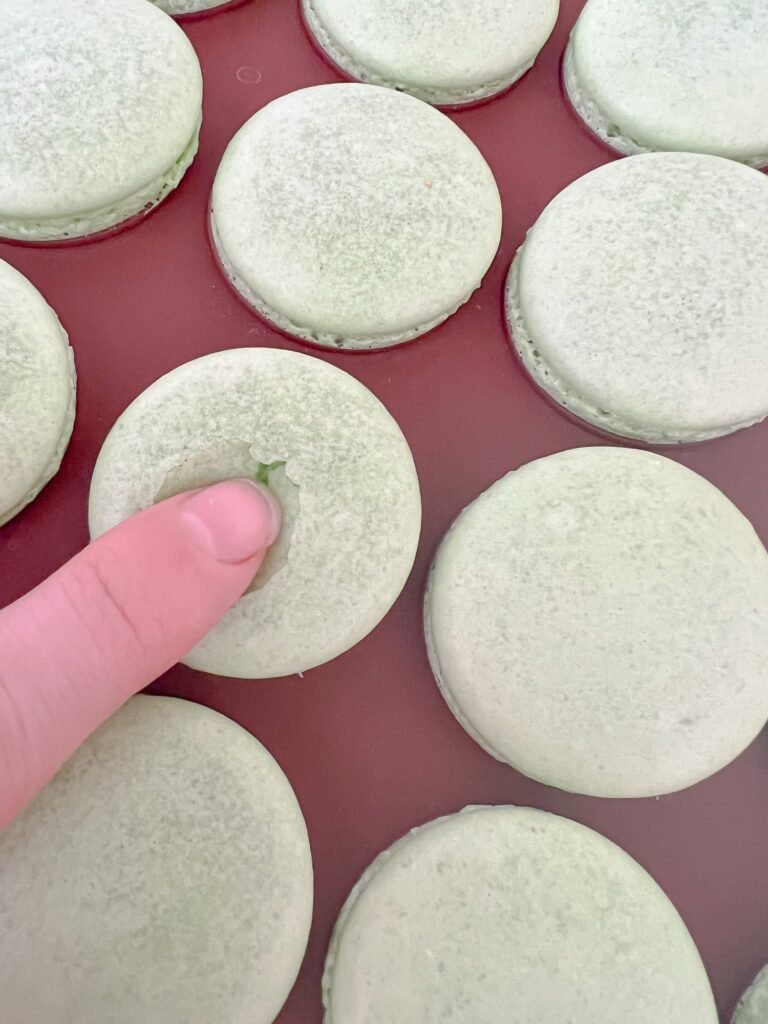
Low oven temperature
When the temperature is too low the macarons won’t have enough heat to fully bake. It can cause a lot of problems. Try using a little higher temperature next time.
Over-mixed
The over-mixed batter gets too runny and has the “too wet” consistency that can ruin your macarons. There is an easy way to check if your macaron batter is ready for piping. The batter should flow from the spatula like a ribbon that doesn’t break. You should be able to “write” the number 8 without it breaking.
Too much food coloring
Using too much food coloring can turn the batter wet and make the macaron shell fragile when baked. Next time, try to use only a tiny bit of food coloring and make sure it is gel-based high-quality food color.
Oily ingredients
Make sure your ingredients aren’t too oily. Almond flour has a high percentage of fat and it doesn’t go well with meringue. Some almond flours are extra oily and you can see and feel it right away – touch the flour with your fingers to see if it is too oily or not. In case it feels oily, lay the flour on the baking sheet and dry it in the oven for 30-60 minutes on low heat.
Under-baked
As stated in the first point, when the temperature is too low, the macarons won’t have enough heat to fully bake. They turn out under-baked when you bake them for too short.
Under-whipped meringue
Under-whipped meringue can also make the batter too runny and cause other problems as well. Make sure you whip the meringue until stiff peaks appear.
Macaron batter piped out too late
Macaron batter does not want to sit in the piping bag for too long. Pipe the macarons out on the parchment paper or silicone mat as fast as you can. The batter can change its consistency over a very short period of time and get thicker sitting in the piping bag. I would not let it sit over 30 minutes if possible.
Macarons with no bottom or sticky bottom


Undercooked
The macaron bottom can easily stick to the silicone mat or baking sheet if they are under-cooked. One of the ways to fix it is to bake your macarons in the oven a few minutes longer than before. Also, always let your macarons cool down before you remove them from the mat.
Even if the macarons are well enough baked and you start removing them right away, they may still stick to the mat even if they are not under-cooked. Sometimes macarons with a lot of added food coloring need longer baking time.
Low oven temperature
Low oven temperature may be the cause of your macarons not having bottoms or having a very sticky one. You should definitely try using an oven thermometer to make sure that you’re baking at a high enough temperature. Try experimenting with baking time and temperature settings to see if that solves the problem.
Baking multiple pans at the same time
Some people have reported that using two pans simultaneously can cause their macarons not to bake properly. When using two pans, there is less heat in your oven and that could be the reason for the “sticky” or “bottomless” macaron shells.
Macarons are too far from the heat source
Being too far away from the heat source may also cause your macarons to not develop a bottom. It’s important to experiment with rack levels, too.
You are using a silicone mat
Sometimes the macarons are well enough baked but still stick to the silicone mat. Macaron tends to stick to the silicone mat more than to the parchment paper.
I have found a great hack for that problem – place the silicone mats with the sticky macarons in the freezer for about 10 minutes. After that, take them out from the freezer and quickly remove the macarons from the mats by gently pushing the back of the mat with your fingers.
Hollow macarons
One of the most common problems new bakers will face when baking macarons is hollow inside. This can happen for numerous reasons and can be extremely frustrating. Even experienced bakers encounter this issue occasionally, so don’t be too sad if this happens to you too.
In most cases, it will look ideal from the outside and there are no visual signs of any problems. When bitten or cut in half, a hollow macaron reveals it’s partially empty inside.
As it is quite a complex problem and there can be several explanations for the issue, I have written a completely separate post about troubleshooting hollow macarons that covers all the information you need to get back on track.


Macarons with no feet
A well-raised macaron foot is often cited as a sign of a high-quality macaron. In fact, some pastry chefs will even discard macarons with poorly raised feet. Unfortunately, it is a very common issue for new bakers and can be utterly frustrating.
There are several factors that can affect the height of a macaron foot. Wrong temperature or mode in the oven, too humid weather, letting macarons rest too long, and wrong baking time all play a role. However, the most important factor is the consistency and quality of the batter.
You can learn more about the reasons and fixes below:
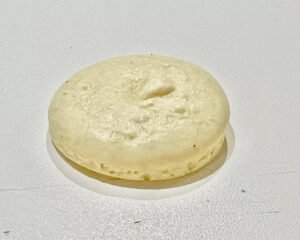
Too low oven temperature
Low oven temperature is the main reason the macaron’s feet are not developing. Try to add a little bit more heat next time or change the oven mode. Sometimes the fan mode helps to raise the foot. I personally love using the fan mode when baking macarons.
Resting too long
The problem can be in resting your macarons for too long. Try to put them in the oven as soon as the skin starts to form. It should take around 15-30 minutes maximum. Resting them longer may cause the skin to be too hard and can prevent it to raise the foot.
Wrong oven mode
Sometimes the fan mode helps to raise the foot. I personally love using the fan mode when baking macarons. Every oven is different, so it is highly suggested to experiment with various modes and find the best one for your use case.
Humid weather
Humid weather and macarons are not friends, they just don’t go well together. If you live in a very humid climate, you should be well-prepared before making macarons.
Close the windows, turn on the kitchen hood, and if possible, use the dehumidifier for best results.
Too wet batter
As previously mentioned, improper batter consistency can cause various problems, including the feet not rising. In most cases, the batter is too wet. This can be caused by using too much food coloring.
Exploded macarons
It can be frustrating to see your macarons having vulcano-shaped cracks all over them. But why did my macarons explode?
In most cases, it is because of the too high cooking temperature in the oven. Also, overmixing can cause the macarons to become tough and chewy. This will make them more likely to explode in the oven.
Too high temperature
If your macarons explode in the oven then the temperature is probably too high. Macarons need to be baked at a low temperature in order to cook evenly and avoid exploding.
In case, your oven is too hot, macarons will cook too quickly on the outside while the inside remains uncooked. Your macarons can start to erupt similarly to a volcano and ruin its appearance.
To fix this issue, try to lower the heat in the oven and place macarons on the lower rack.


Macarons with cracked shells
Macarons can be notoriously tricky to make, and you may find yourself with a batch of macarons that have cracks. This can be due to a variety of reasons, but a few common ones are:
- Not resting macarons long enough before putting them in the oven
- Under whipped meringue
- Too high temperature in the oven
- Too much food coloring
- Overmixing the batter

Not resting macarons long enough
It is an endless discussion about resting the macarons. Some bakers always rest their macarons before the oven, while other bakers never rest them. In my opinion, you should try both methods and see what is working best for you.
As a beginner, you should definitely try resting them. After gaining more experience and understanding your oven better, you can start trying to skip the resting part.
Resting is very important if you are living in a humid climate. Sometimes, the moisture inside the macarons will cause them to crack.
The macaron is enough rested when it turns matte-looking. You can touch the macaron with your finger and it should not be sticky.
Macarons with a lot of food coloring inside them should be rested a little longer than less colorful ones because food color can make the batter wetter.
Under-whipped meringue
Macarons are incredibly delicate sweets and need a lot of precision in every step. Handling them improperly can cause issues with the end product like cracked shells.
This can happen because whipped meringue does not provide enough strength, and will dissipate as you fold in dry ingredients. Always make sure the meringue is at stiff peaks before adding the dry ingredients.
Too high oven temperature
Try lowering the temperature next time you are baking macarons. Too high temperatures can cause cracks. Using an extra thermometer in the oven also helps you to figure out a suitable temperature.
Too much food coloring
Too much food coloring can turn your batter too wet and can cause cracked shells. Always use gel-based food coloring, and do not over-dose them. Experiment with different amounts and find the perfect consistency for your own use case.
TIP: I have written a full article about which food coloring is best for macarons. This post goes into depth with many important tips and tricks and even has suggestions for the best colors to choose from.
Macarons with tall feet
The key to making perfect macarons is getting the feet just right. This can be a great challenge for even an experienced baker.
Sometimes the macaron’s feet are too tall and it doesn’t look good. Below are some tips to make sure this doesn’t happen again in the future.
Over-whipped meringue
When you whip meringue too much, the air bubbles will cause your feet to get very tall. While the macarons are being baked, the high amount of air in its shell expands and makes the feet rise.
Make sure the meringue is at stiff peaks, and stop whipping as soon as it begins to form stiff peaks that are shooting straight up.
Too high temperature
If the temperature is too high in the oven, the batter will rise too fast. That can cause too tall feet and hollow macarons.

Grainy macaron shells
Sometimes macaron shells can come out with a grainy texture instead of being smooth like the ones in the bakery. You can find some reasons below that may cause this issue and how to fix it if it does happen to show up in your kitchen.

Not sifted dry ingredients
Always sift all the dry ingredients to remove larger parts. There is no way to save the grainy macarons but they still taste as good as smooth ones. Just try to improve your techniques when baking macarons the next time.


Not enough crushed almonds
Macarons can turn out grainy when the almond flour is not crushed enough. Most commonly it happens to homemade almond flour, but sometimes even expensive flour from the store can be with large pieces.
Wrong measurements
A kitchen scale is a must when you are making macarons! It is extremely important to correctly weigh all the ingredients. If you have too many almonds, the macarons can turn out grainy.
Can you save grainy macaron batter?
You can not save the batter once it is already mixed together with egg whites and other ingredients. Be more careful next time – evaluate the almond flour, and blend more when needed.
Macarons with bumpy tips
Macarons with bumpy tips is a common problem that can be caused by a variety of issues. If this has happened to you too, don’t worry – there might just be an easy solution.
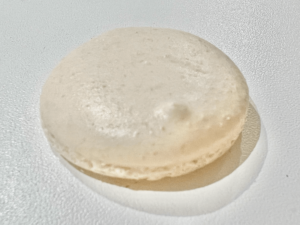
Under-mixed batter
The most common reason is that the batter is under-mixed. In that case, the batter is too stiff and won’t spread evenly. This can easily cause bumpy tips on your macarons. Next time, fold the batter a little more. Your batter is ready when it nicely flows down from the spatula without breaking.
Not well enough sifted dry ingredients
If the dry ingredients are not well sifted, the batter can be uneven and have some bumps and lumps in there. This is why it is very important to correctly sift the dry ingredients.
Over-whipped meringue
Over-whipped meringue is usually too sift and you can’t get the right textured macaron batter. In most cases, the batter will be too thick and it doesn’t flow evenly.
Be careful and do not over-whip the meringue! Once you have the stiff peaks, stop whipping.
Wrong piping method
You should always pipe the batter at a 90-degree-angle to get the best-looking macarons. Sometimes, if you pipe the macaron batter some other way, the batter will not flow evenly and you can get unwanted bumps and lumps on top of the macarons.
Macarons with air bubbles (air pockets)
Macarons with air bubbles are a common problem that can be caused by a number of factors. Below we’ll discuss the reasons for air bubbles in macarons and some fixes that may help.
Not tapping the tray
Sometimes when piping out the macaron batter on a tray, the air stays inside and can cause numerous problems. You should always gently tap the tray after piping macarons. You can do it by hand or by tapping it on your kitchen work surface.
Over-mixing the macaron batter
Over-mixing can also be the reason for the air bubbles. When folding the batter too many times, the excess air gets into the batter and can cause air bubbles. In this case, it is very important to tap the tray to get rid of them all.
Folding the batter too fast
Folding the batter too fast can cause air bubbles because of the same reason as I just wrote – excess air gets into the batter and generates the bubbles.
How to fix air bubbles on macarons?
If air bubbles start appearing before putting macarons into the oven, they can be saved. Just take a toothpick and gently poke the bubbles to let the excess air out.
When you see the air bubbles on your baked macarons then it is too late to get rid of them as they are already baked. You can make them look better by covering the bubbles with decorations or chocolate.
Enjoy your macarons!
Belli xx
